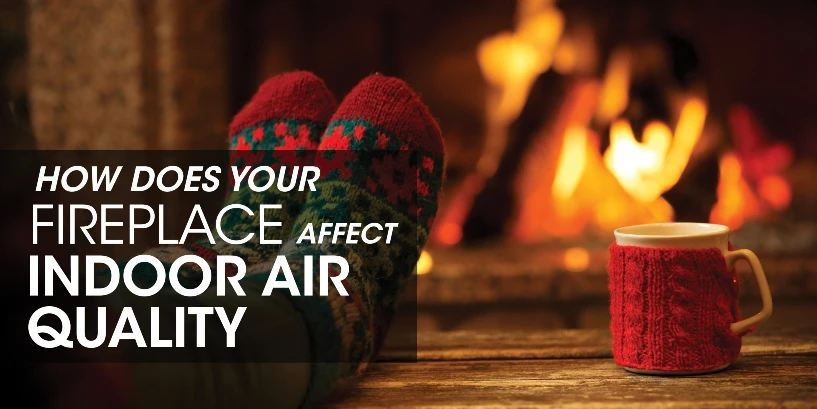How Does Your Fireplace Affect Indoor Air Quality?

Nothing beats the coziness and warmth offered by a fireplace on a cold winter’s eve. Unfortunately, your favorite winter respite may be offering up more than you bargained for – destroying your home’s indoor air quality with dangerous fireplace pollution.
Fireplaces have been around for ages – is fireplace pollution really that bad?
Woodstoves, fireplaces, and gas stove all release dangerous pollutants, including:
- Carbon monoxide (CO)
Often confused with the flu or food poisoning, colorless and odorless CO gas interferes with the body’s ability to utilize oxygen. Low level exposure leads to fatigue, dizziness, weakness, headaches, confusion, and nausea that can progress to loss of consciousness and death as CO levels increase. Infants, elderly and the infirm are most at-risk. Installing and properly maintaining oxygen-depletion sensors and carbon monoxide detectors are key to ensuring safety. - Nitrogen dioxide (NO2)
NO2 is a known eye, nose and throat irritant that can cause shortness of breath in high concentrations. NO2 odor may be noticeable to those with a strong sense of smell. It is linked with an increased incidence of respiratory infection and the development of lung disease, such as emphysema. Those with asthma and respiratory disease are at increased risk of its effects. - Particles
One of the most deleterious wood smoke health effects, particulates released during the incomplete combustion of any fuel (wood or gas) can work their way into and damage the lungs. This can cause difficulty breathing and aggravate existing conditions, particularly asthma, bronchitis, and wood smoke allergies. Long-term damage can be irrevocable, with a number of particulate fireplace pollutants linked to cancer.
Dangers are not the same across the board
Is wood smoke carcinogenic? All fireplaces release harmful emissions. However wood burning releases far more pollutants than gas, and has been identified by the EPA as a significant source of air pollution. However venting also matters, with “ventless” fireplace models, both gas and wood burning, boosting measurable pollutant levels within the home. Very tightly sealed homes may also suffer increased pollution buildup, including not only dangerous gases and particles, but water vapor subsequent to burning that can contribute to mold and mildew.
Take the proper precautions when using your fireplace to protect indoor air quality:
- Choose the proper fuel.
Ensure a hotter, cleaner burning fire by using dried “seasoned” wood, particularly hard woods (maple, ash, oak, beech), which outperform softer pine and fir. Never burn wet, painted, or treated wood. - Don’t neglect routine maintenance.
The routine annual cleaning and inspection of your fireplace and venting system is essential to protecting air quality. Dirty, blocked, cracked and leaking chimney, flues, and venting can result in the release of fireplace pollution in your home, as can improperly installed or incorrectly maintained components. Routine annual inspect can detect these circulation and ventilation issues, heading off problems at the pass. - Add an air purifier.
Whole house HEPA air filtration systems, when added to your heating or cooling system, can help control smoke pollution, removing 99.97% of particles 0.3 microns in size and larger.
Concerned about how your fireplace, combustion appliances, or building envelope may be effecting the indoor air quality of your home? Breathe easier with the help of Aire Serv® today.
 Click to call
Click to call


